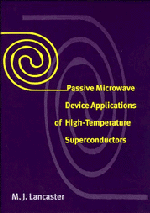Book contents
- Frontmatter
- Contents
- Preface
- Acknowledgements
- 1 Superconductivity at microwave frequencies
- 2 Superconducting transmission lines
- 3 Superconducting cavity resonators
- 4 Microwave measurements
- 5 Superconducting filters
- 6 Superconducting delay lines
- 7 Superconducting antennas
- 8 Signal processing systems
- Appendix 1 The surface impedance of HTS materials
- Appendix 2 Substrates for superconductors
- Appendix 3 Some useful relations
- Index
Appendix 1 - The surface impedance of HTS materials
Published online by Cambridge University Press: 14 September 2009
- Frontmatter
- Contents
- Preface
- Acknowledgements
- 1 Superconductivity at microwave frequencies
- 2 Superconducting transmission lines
- 3 Superconducting cavity resonators
- 4 Microwave measurements
- 5 Superconducting filters
- 6 Superconducting delay lines
- 7 Superconducting antennas
- 8 Signal processing systems
- Appendix 1 The surface impedance of HTS materials
- Appendix 2 Substrates for superconductors
- Appendix 3 Some useful relations
- Index
Summary
Introduction
This appendix looks briefly at the microwave properties of superconducting materials and how these properties vary with external influences. It looks briefly at some of the issues affecting these properties and comments on reasons for specific trends. Its primary motivation is to provide typical values of these properties for the microwave design engineer. Although there are many hundreds of high-temperature superconductors with varying transition temperatures, YBa2Cu3O7−x (YBCO), with a transition temperature of about 92 K, is by far the most popular. The reason for this is historical, but the surface impedance of any of the HTS materials does not improve significantly over YBCO, even though the transition temperature may be higher. As more materials are investigated in detail, with greater emphasis being placed on the optimisation of the surface impedance, the dominance of YBCO may recede. This appendix thus mainly discusses the microwave properties of YBCO, although a brief mention is made of some of the thallium-based superconductors, which have also been studied in the context of microwave engineering. The majority of measurements presented have been made using the coplanar resonator, described in Section 3.8, at The University of Birmingham. The films tested are state-of-the-art and come from a variety of sources. Since the coplanar resonator is used, the results given are therefore taken on a structure which is close to the final application, and includes any effects due to film patterning.
- Type
- Chapter
- Information
- Publisher: Cambridge University PressPrint publication year: 1997
- 2
- Cited by



